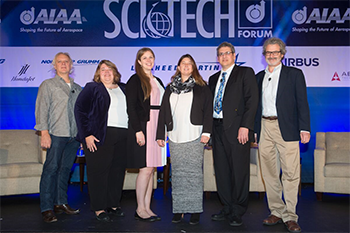Enhancing Aerospace Capabilities With Computing, Robots and Automation Written 12 January 2017
Panelists: Moderator Samantha Marquart Brainard, doctoral candidate, George Washington University; Danette Allen, senior technologist for intelligent flight systems, NASA's Langley Research Center; Neil Gershenfeld, director, The Center for Bits and Atoms, Massachusetts Institute of Technology; Rob High, IBM Fellow and vice president and chief technology officer, IBM Watson; Robert Lutwak, program manager, Microsystems Technology Office, DARPA
by Hannah Godofsky, AIAA Communications

Machines are capable of doing more with less input from humans and will soon be able to assemble other structures or machines, inevitably opening up new possibilities for aerospace, a panel of experts said Jan. 12 at the 2017 AIAA SciTech Forum in Grapevine, Texas.
Danette Allen, senior technologist for intelligent flight systems at NASA's Langley Research Center, has worked at NASA for decades. In the "Disruptive Technology Developments — Breakthroughs That Will Transform Aerospace" panel, she said over the past 30 years, technology has changed in a myriad of ways. She mentioned autonomy as one of those changes and said it is altering not only the way humans and computers interact, but also aerospace.
"We're at the dawn of what a lot of people call an autonomy revolution," she said. "When we talk about these systems that learn, when we talk about these systems that adapt, we are changing the way we talk about the way humans interact with these machines."
For example, humans can now delegate their responsibilities to computers or team up with them.
"A lot of this stuff is spinning in from our mobile devices, speech recognition … from gaming, we've got gesture recognition," said Rob High, IBM Fellow and vice president and chief technology officer of IBM Watson. "It is our firm belief that cognitive computing will have its greatest value and most disruptive benefit when we use it to amplify human cognition."
High said the ultimate goal is for cognitive computing to become capable of focusing on human experiences and expression to be able to understand intention and then to use that understanding to solve problems and consider alternative solutions.
"We simply cannot consume all of the information that is available to us," he said. "We need something like a cognitive computing system that is able to facilitate and augment our own reasoning."
Robert Lutwak, a program manager at DARPA, said advancements in computer hardware as a disruptive development could accelerate the advance of cognitive computing and autonomy.
"On-chip optical frequency control [is] the key disruptive device technology that's coming along right now," he said. "In the near future, within the next six months, we're going to have prototype single-chip optical frequency digital synthesizers."
In regards to the impact on aerospace, MIT's Neil Gershenfeld said automation and robotics could lead to self-assembling structures. He added that future space explorers could utilize automation to build habitats.
"An ensemble of little robots can build scalable big structures," he explained. "To make large-scale space structures, you can flat-pack them and have a little ensemble of assemblers with the flat-pack structure that then scales to a big thing."
Gershenfeld also described a future aircraft assembly line in which the airframes are assembled from small pieces by robots.
"We're working on this to make airframes without the supply chain," he said.
